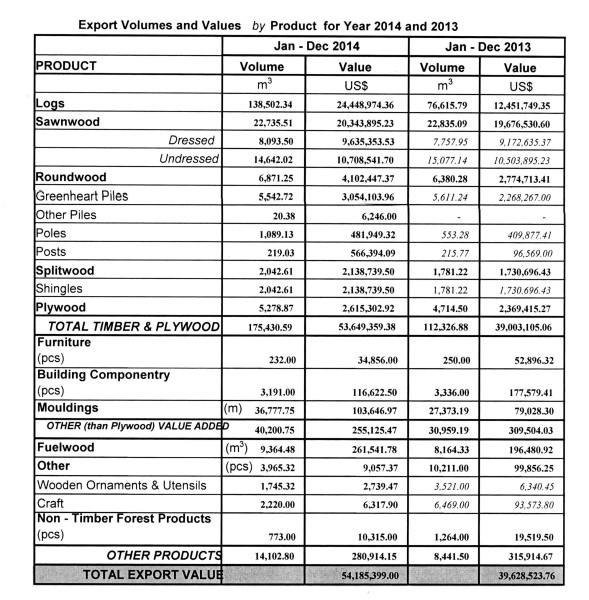Exports of logs were up by a staggering 80.77% last year over the figure in 2013, according to the 2014 annual report of the Guyana Forestry Commission (GFC).
Tabled in Parliament recently, the log export figure will add to concerns that Asian investors are creaming off low priced logs without adding value in line with their commitments.
In value, the log exports were up by 96.3% in 2014 compared to the preceding year. Logs were the number one export earner in the timber category and dwarfed what was supposed to be one of the longstanding value-added items, plywood.
Between January to December 2014, 138,502 cubic metres of logs were exported at a value of US$24.4 million compared to 76,615 cubic metres of logs in 2013 at a value of US$12.4 million. By comparison, plywood exports in 2013 amounted to only 5,278 cubic metres at a value of US$2.6 million. In 2013, plywood exports totaled 4,714 cubic metres at a value of US$2.3 million. Barama Company Limited has been the producer of plywood in the country and the figure would suggest that it is also exporting other timber products including logs whereas its investment agreements should have required exclusive focus on plywood and other value-added products.
 Sawnwood was the next largest category. The annual report said that in 2014, 22,735 cubic metres were exported at a value of US$20.3 million. In 2013, the corresponding figures were 22,835 cubic metres and US$19.6 million.
Sawnwood was the next largest category. The annual report said that in 2014, 22,735 cubic metres were exported at a value of US$20.3 million. In 2013, the corresponding figures were 22,835 cubic metres and US$19.6 million.
In terms of roundwood, in 2014 Greenheart Piles accounted for 5,542 cubic metres at a value of US$3.05 million. The corresponding figures in 2013 were 5,611 cubic metres at a value of US$2.26 million.
Furniture exports amounted to 232 pieces in 2014 at a value of US$34,856 compared to 250 in the preceding year at a value of US$52,896.
Total exports of forest products for the year amounted to US$54.2 million with logs at US$24.5 million accounting for 45%.
The report said that logs are mainly being exported to India and China. Controversial Chinese company Baishanlin and equally contentious Indian company, Vaitarna are said to be among the main exporters to these markets. Both Baishanlin and Vaitarna have been accused of failing to stick to their investment commitments while all the time exporting logs.
The APNU+AFC administration is said to be reviewing its plans for this sector. The GFC is one of the agencies that is to be audited by the government.
As if to play down the impact of log exports, the GFC report said, “Although log export volume recorded a significant increase in 2014, it represents only 34% of total log production in 2014. The remaining 66% was available for in country added value processing chains for exportation; as well as for local utilization in the construction and other sectors.”
The report said that total timber production for 2014 was 530,864 cubic metres and when veneer and plywood were added, the figure became 572,236 cubic metres. This compares to 437,922 cubic metres in 2014 and 473,031 cubic metres in 2013. Overall, timber production was up by 21% over 2013’s figure. The total number of Greenheart piles produced in 2014 was 17,633 cubic metres compared to 15,787 cubic metres in 2013. Wallaba poles totalled, 4,067 cubic metres in 2014 compared to 2,271 cubic metres in 2013.
In terms of financial performance, the GFC recorded a net surplus for 2014 of $163 million compared to $172.1 million in the preceding year. The main revenue generator for 2014 was royalty at $334.9 million followed by commission on exports at $220 million, acreage fees at $178 million and licensing and other fees and compensation at $126 million.
On the National Log Export Policy, the report had one line: “Year 2014 marked the penultimate year of implementation of the current National Log Export policy.”
Among its initiatives for this year, the GFC cited enhanced value-added activities, stimulation of greater foreign and local investment in the sector and improving production, processing/manufacturing and export of forest produce.










